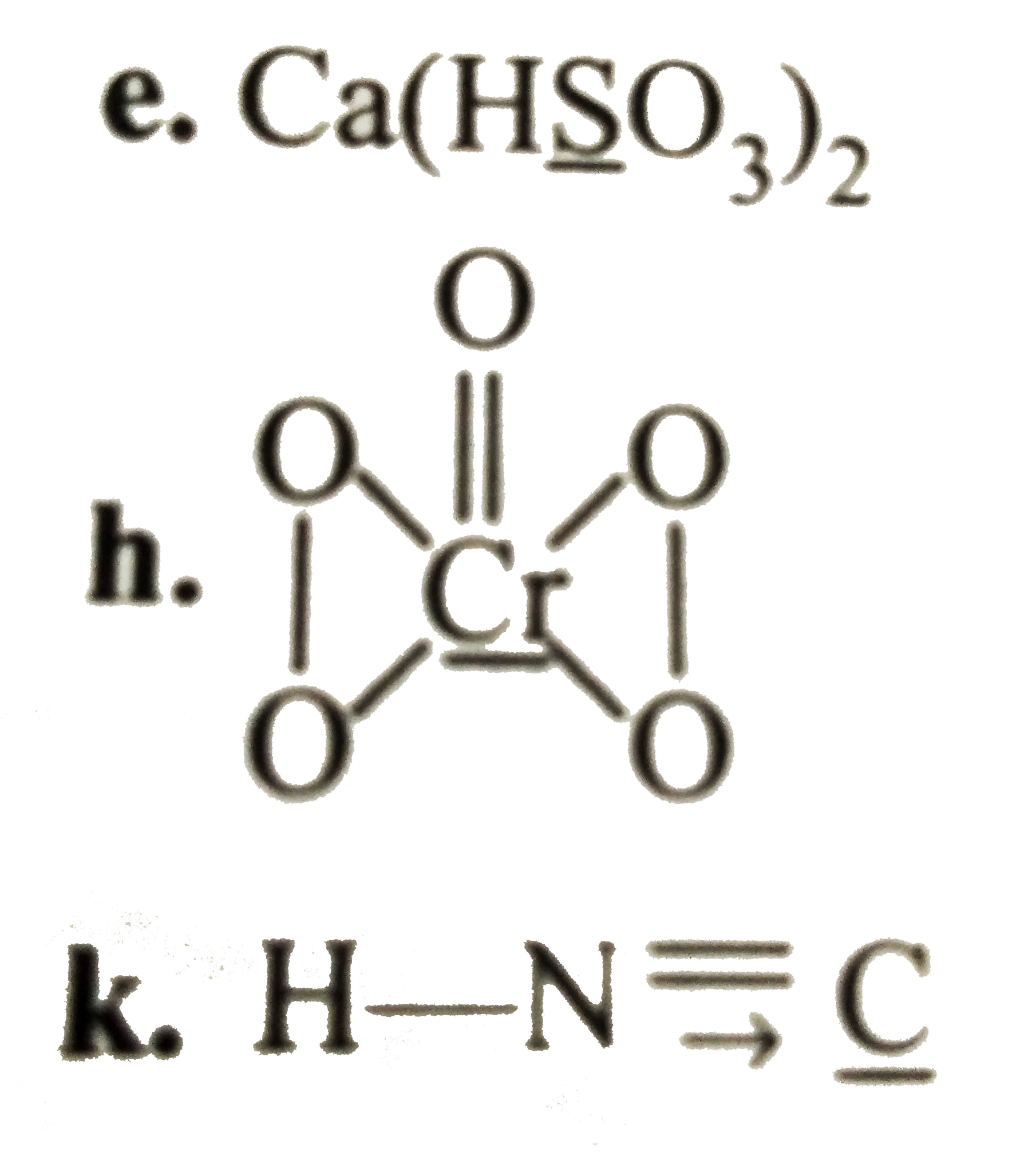Complete Solutions to Exercise of chapter REDOX REACTIONS of Class 11 book with complete answers and questions
| Class 11 | CHEMISTRY |
| Chapter | REDOX REACTIONS |
| CENGAGE CHEMISTRY | Exercise |
| Number Of Questions | 29 |
| Academic Year | 2023-24 |
In the following reactions:
a. `3MnO_(2)+4Alrarr3Mn+2Al_(2)O_(3)`
b. `2MnO_(4)^(ө)+16H^(o+)+10Cl^(ө)rarr2Mn^(2+)+5Cl_(2)+8H_(2)O`
Which species is reduced and which is oxidised?
View SolutionWhich of the following are redox reactions?
View SolutionWhat is the sum of oxidation numbers of various elements in `HCO_(3)^(ө)` (bicarbonate) ion?
View SolutionWhat is the oxidation numbr of iodine in each of the following compounds: `IF_(7), IF_(5),KI,I_(2), ICI,HIO_(4)`?
View SolutionWhat is the oxidation number of `Mn` is `KMnO_(4)" "K_(2)MNO_(4)" "MnSO_(4)" "MnO_(2)`, and `Mn_(3)O_(4)`?
View SolutionWhat is the oxidation number of `Mg` and `N` in magnesium nitride?
View SolutionWhat is the oxidation number and valency of carbon in methanal `(HCHO)`?
View SolutionWrite the following redox reactions using half equations:
a. `Zn(s)+PbCl_(2)(aq)rarrPb(s)+ZnCl_(2)(aq)`.
b. `2Fe^(3+)(aq)+2I^(ө)(aq)rarrI_(2)(aq)+2Fe^(2+)(aq)`
c. `2Na(s)+Cl_(2)(g)rarr2NaCl(s)`
d. `Mg(s)+Cl_(2)(g)rarrMgCl_(2)(s)`
e. `Zn(s)+2H^(o+)(aq)rarrZn^(2+)(aq)+H_(2)(g)` .
View SolutionIn the reaction given in euaqution 8, mention:
I. Which reactant is oxidised? To what?
II. Which reactant is the oxidiser?
III.Which reactant is reduced? To what?
IV. What reactant is the reducer?
View SolutionWrite correctly balanced equaitons for the following redox reaction. Using half reaction:
a. `H_(2)S+Fe^(3+)rarrFe^(2+)+Sdarr+H^(o+)`
b. `I^(ө)+IO_(3)^(ө)+H^(o+)rarrI_(2)+H_(2)O`
c. `Bi(s)+NO_(3)^(ө)+H^(o+)rarrNO_(2)+Bi^(3+)+H_(2)O`
d. `I^(ө)+O_(2)(g)+H_(2)OrarrI_(2)+overset(ө)OH`
e. `Cu(s)+Au^(o+)rarrAu(s)+Cu^(2+)`
View SolutionIn question `10`, state which element is oxidised by which element and what is reduced to what in the reactions expressed by the respective equaitons.
View SolutionBalance the following redox reactions.
Coppoer reacts with nitric acid, a brown, gas is formed and solution turns blue.
a. `Cu+NO_(3)^(ө)rarrNO_(2)+Cu^(2+)`
b. `Cr(OH)_(4)^(ө)+H_(2)O_(2)rarrCrO_(4)^(2-)+H_(2)O` (basic solutions)
c. `SnO_(2)+CrarrSn+CO`
d. `Fe_(2)O_(3)+CrarrFe+CO`
View SolutionWrite correctly balanced half reactions and overall equations for the following skeletal equations:
a. `NO_(3)^(ө)+Bi(s)rarrBi^(3+)+NO_(2)` ( in acid solution)
b. `Fe(OH)_(3)(s)+H_(2)O_(2)rarrFe(OH)(s)+H_(2)O+O_(2)` (in basic medium)
c. `Cr_(2)O_(7)^(2-)+C_(2)H_(4)OrarrC_(2)H_(4)O_(2)+Cr^(3+)` (in acid solutions)
d. `MnO_(4)^(ө)+H_(2)C_(2)O_(4)rarrMn^(2+)+CO_(2)uarr` (in acid solutions)
e. `Al(s)+NO_(3)^(ө)rarr[Al(OH)_(4)]^(ө)+NH_(3)` (in basic solution)
f. `Cr_(2)O_(7)^(2-) + Fe^(2+) rarr Fe^(2+) + Cr^(3+)` (in acid solution)
g. `MnO_(4)^(Ө) + Br^(Ө) rarr Mn^(2+) + Br_(2)` (in acid solution)
h. `PbO_(2) + Cl^(Ө) rarr ClO^(Ө) +[Pb(OH)_(3)]^(Ө) ` (in basic solution)
View SolutionStarting with correctly balanced half reactions, write the overall net ionic reaction in the following changes:
a. Chloride ion is oxidised to `Cl_(2)` by `underline(Mn)O_(4)^(Ө)` in acid solution.
b. Nitrous acid `(Hunderline(N)O_(2))` reduce `MnO_(4)^(Ө)` in acidsolution.
c. Nitrous acid `(Hunderline(N)O_(2))` oxidises `I^(Ө)` to `I_(2)` in acid solution.
d. Chlorate ion `(underline(Cl)O_(3)^(Ө))` oxidises `Mn^(2+)` to `MnO_(2)(s)` in acid solution.
e. Chromine ion `(underline(C )rO_(3)^(Ө))` is oxidation numbers of the basic solution.
Also find out the change in oxidation numbers of the underline atoms.
View SolutionAssign oxidation numbers to the elements in the following ionic compounds.
a. `NaBr` , b. `MgO` , c. `AlF_(3)`
View SolutionCalculate the oxidation number of the underlines elements:
a. `underline(P)H_(3)` , b. `underline(M)gO` , c. `Hunderline(N)O_(3)` , d. `H_(3)underline(P)O_(4)`
View SolutionCalculate the oxidation number of the underlined elements in the following compounds:
a. `Kunderline(Mn)O_(4)` , b. `underline(Cr)O_(2)Cl_(2)` , c. `Naunderline(I)O_(3)`
View SolutionWhat is the oxidation number of the underlined elements?
a. `H_(2)underline(S)` , b. `H_(2)underline(S)O_(4)` c. `Naunderline(S_(2))O`
d. `Na_(2)underline(S_(4))O_(6)` e. `Ca(Hunderline(S)O_(3))_(2)` f. `H_(2)underline(S_(2))O_(8)`
g. `H_(2)underline(S)O_(5)` , h. , i. `underline(N)H_(4)underline(N)O_(3)` , j. `H-underline( C)-=N` , k. `H-Nunderset(rarr)(=)underline(C)` , l. `Hunderline(N)O_(4)`
, i. `underline(N)H_(4)underline(N)O_(3)` , j. `H-underline( C)-=N` , k. `H-Nunderset(rarr)(=)underline(C)` , l. `Hunderline(N)O_(4)`
View SolutionBalance the following equation stepwise:
`Cr_(2)O_(7)^(2-) + Fe^(2+)++H^(o+)rarrCr^(3+) + Fe^(3+) + H_(2)O`
View SolutionBalance the following equation in a basic solution stepwise:
`NO_(3)^(Ө) + ZnrarrZn^(2+) + NH_(4)^(o+)`
View SolutionBalance the following equations by the ion electron method:
a. `MnO_(4)^(Ө) + Cl^(Ө) + H^(o+) rarr Mn^(2+) + H_(2)O + Cl_(2)`
b. `Cr_(2)O_(7)^(2-) + I^(Ө) + H^(o+) rarr Cr^(3+) + H_(2)O + I_(2)`
c. `H^(o+) + SO_(4)^(2-)+I^(Ө) rarr H_(2)S+H_(2)O+I_(2)`
d. `MnO_(4)^(Ө)+Fe^(2+) rarr Mn^(2+) + Fe^(3+) + H_(2)O`
View SolutionBalance the following equations by oxidation number method:
a. `Fe^(2+) + Sn^(+2) rarr Sn^(4+) + fe^(2+)`
b. `MnO_(4)^(Ө) + H_(2)S rarr S+Mn^(2+)`
c. `Cr_(2)O_(7)^(2-) + 2I^(Ө) rarr 2Cr^(3+) + I_(2)`
d. `Zn + NO_(3)^(Ө) rarr Zn^(2+) + NH_(4)^(o+)`
e. `MnO_(4)^(Ө)+SO_(3)^(2-) rarr SO_(4)^(2-)+MnO_(2)`
f. `Cl_(2)+IO_(3)^(Ө) rarr IO_(4)^(Ө)` (in basic medium)
View SolutionBalance the following equations by ion electron method:
a. `Cr_(2)O_(7)^(2-) + C_(2)H_(4)O+H^(o+) rarr 2Cr^(3+) + C_(2)H_(4)O_(2) + H_(2)O`
b. `Cu_(2)O + H^(o+)+NO_(3)^(Ө) rarr Cu^(2+)+NO+H_(2)O`
View SolutionBalance the following equations by ion electron (half reaction) method for each of the following equations:
a. `Cr_(2)O_(7)^(2-) + Fe^(2+) rarr cr^(3+) + Fe^(3+) + H_(2)O`
b. `H_(2)O_(2) + I^(Ө) + H^(o+) rarr H_(2)O + _(2)`
c. `AsO_(3)^(3-) + H^(o+)+IO_(3)^(Ө) rarrAsO_(4)^(3-)+I^(Ө)` (in acid medium)
d. `Cr_(2)O_(7)^(2-) + H^(o+)+Cl^(Ө) rarr3Cr^(3+) + Cl_(2)+H_(2)O`
e. `MnO_(4)^(Ө)+Fe^(2+) rarr Mn^(2+)+Fe^(3+)` (in alkaline medium)
View SolutionIndicate in the following reactions which of the reactants, if any, are oxidised or reduced:
a. `2HI(aq)+Cl_(2)(aq) rarr I_(2)(s) + 2HCl(aq)`
b. `2MnO_(2) + 4Al rarr 3Mn +2Al_(2)O_(3)`
c. `2MnO_(4)^(Ө) + 10Cl^(Ө) + 16H^(o+) rarr 2Mn^(2+) + 5Cl_(2) + 8H_(2)O`
d. `2Cu^(2+)+2Br^(Ө)+SO_(2)+H_(2)Orarr 2CuBr+4H^(o+)`
View SolutionOne mole of `N_(2)H_(4)` loses ten moles of electrons to form a new compound `A`. Assuming that all the nitrogen appears in the new compound, what is the oxidation state of nitrogen in `A`? (There is no change in the oxidation state of hydrogen.)
View SolutionIn the reaction:
`Cr_(2)O_(7)^(2-) + 14H^(o+) + 6I^(Ө) rarr2Cr^(3+) + 3H_(2)O + 3I_(2)`
Which element is reduced?
View SolutionIn the following equation, `MnO_(2)` acts as
`MnO_(4)^(2-) + 2H_(2)O + 2E^(-) rarr MnO_(2) + 4overset(Ө)(OH)`
View SolutionBalance the following equations by ion electron method:
a. `CuO + NH_(3) rarr Cu+H_(2)O+N_(2)`
b. `HNO_(3)+I_(2) rarr HIO_(3) + NO_(2) + H_(2)O`
View Solution
Exercise questions and complete solutions for chapter REDOX REACTIONS of CENGAGE CHEMISTRY (HINGLISH) of Class 11